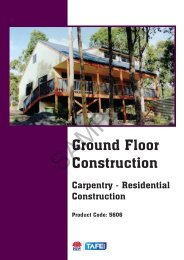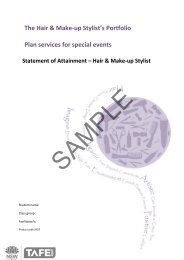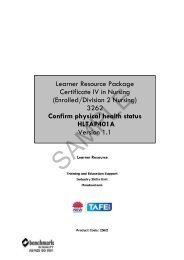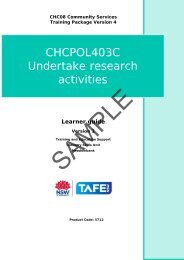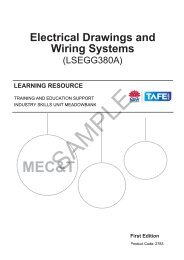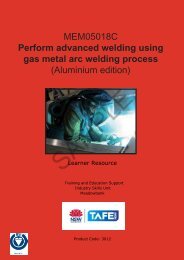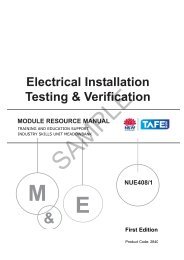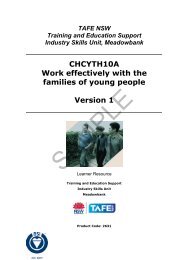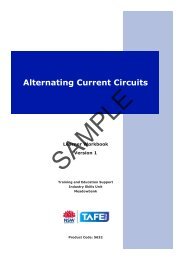Product Code: 3053 TRAINING AND EDUCATION ... - vetres
Product Code: 3053 TRAINING AND EDUCATION ... - vetres
Product Code: 3053 TRAINING AND EDUCATION ... - vetres
You also want an ePaper? Increase the reach of your titles
YUMPU automatically turns print PDFs into web optimized ePapers that Google loves.
SAMPLE
AcknowledgmentsThe TAFE NSW Training and Education Support Industry Skills Unit, Meadowbank would like toacknowledge the support and assistance of the following people in the production of this learnerresource guide:Writer:Sarah MurrayConsultantReviewer:Catherine LeeDirectorThe Point Pre-schoolNSWProject Manager:Gail HorwoodA/Education Programs ManagerTAFE NSWDesktop Publishing:Joanna SantosTAFE NSWEnquiriesEnquiries about this and other publications can be made to:Training and Education Support Industry Skills Unit, MeadowbankMeadowbank TAFELevel 3, Building J,See Street,MEADOWBANK NSW 2114Tel: 02-9942 3200 Fax: 02-9942 3257SAMPLE© The State of New South Wales, Department of Education and Training, TAFE NSW,Training and Education Support Industry Skills Unit, Meadowbank, 2009.Copyright of this material is reserved to TAFE NSW Training and Education SupportIndustry Skills Unit, Meadowbank. Reproduction or transmittal in whole or in part, otherthan for the purposes of private study or research, and subject to the provisions of theCopyright Act, is prohibited without the written authority of, TAFE NSW. Training andEducation Support Industry Skills Unit, MeadowbankISBN 978 1 74236 127 7TAFE NSW Training and Education Support, Industry Skills Unit, Meadowbank © 2010 V1 3
Table of contentsIntroduction . . . . . . . . . . . . . . . . . . . . . . . . . . . . . . . . . . . . . . . . . . . . . . . . . . . . . . . . . . . . . . . . . . . 71. General introduction. . . . . . . . . . . . . . . . . . . . . . . . . . . . . . . . . . . . . . . . . . . . . . . . . . . . . . . . . . . . . . 72. Using this participant guide . . . . . . . . . . . . . . . . . . . . . . . . . . . . . . . . . . . . . . . . . . . . . . . . . . . . . . . . 73. Prior knowledge and experience . . . . . . . . . . . . . . . . . . . . . . . . . . . . . . . . . . . . . . . . . . . . . . . . . . . . 94. Unit of competency overview . . . . . . . . . . . . . . . . . . . . . . . . . . . . . . . . . . . . . . . . . . . . . . . . . . . . . . 95. Assessment . . . . . . . . . . . . . . . . . . . . . . . . . . . . . . . . . . . . . . . . . . . . . . . . . . . . . . . . . . . . . . . . . . . . 13What is sustainability? . . . . . . . . . . . . . . . . . . . . . . . . . . . . . . . . . . . . . . . . . . . . . . . . . . . . . . . . . . 15Aspects of sustainability. . . . . . . . . . . . . . . . . . . . . . . . . . . . . . . . . . . . . . . . . . . . . . . . . . . . . . . . . 19Environmental sustainability. . . . . . . . . . . . . . . . . . . . . . . . . . . . . . . . . . . . . . . . . . . . . . . . . . . . . . . . . . . 19Social sustainability . . . . . . . . . . . . . . . . . . . . . . . . . . . . . . . . . . . . . . . . . . . . . . . . . . . . . . . . . . . . . . . . . . 19Economic sustainability . . . . . . . . . . . . . . . . . . . . . . . . . . . . . . . . . . . . . . . . . . . . . . . . . . . . . . . . . . . . . . . 19The impact of key global issues . . . . . . . . . . . . . . . . . . . . . . . . . . . . . . . . . . . . . . . . . . . . . . . . . . . 21Climate change. . . . . . . . . . . . . . . . . . . . . . . . . . . . . . . . . . . . . . . . . . . . . . . . . . . . . . . . . . . . . . . . . . . . . . 21Greenhouse effect . . . . . . . . . . . . . . . . . . . . . . . . . . . . . . . . . . . . . . . . . . . . . . . . . . . . . . . . . . . . . . . . . . . 23Ecological footprint . . . . . . . . . . . . . . . . . . . . . . . . . . . . . . . . . . . . . . . . . . . . . . . . . . . . . . . . . . . . . . . . . . 26Earth resources. . . . . . . . . . . . . . . . . . . . . . . . . . . . . . . . . . . . . . . . . . . . . . . . . . . . . . . . . . . . . . . . . . . . . . 28Waste . . . . . . . . . . . . . . . . . . . . . . . . . . . . . . . . . . . . . . . . . . . . . . . . . . . . . . . . . . . . . . . . . . . . . . . . . . . . . 38Chemicals . . . . . . . . . . . . . . . . . . . . . . . . . . . . . . . . . . . . . . . . . . . . . . . . . . . . . . . . . . . . . . . . . . . . . . . . . . 40SAMPLEBiodiversity . . . . . . . . . . . . . . . . . . . . . . . . . . . . . . . . . . . . . . . . . . . . . . . . . . . . . . . . . . . . . . . . . . . . . . . . . 43Sustainable resources . . . . . . . . . . . . . . . . . . . . . . . . . . . . . . . . . . . . . . . . . . . . . . . . . . . . . . . . . . . . . . . . 46Potential aspects for change in children’s services. . . . . . . . . . . . . . . . . . . . . . . . . . . . . . . . . . . . 59Sustainable building design and associated structural aspects . . . . . . . . . . . . . . . . . . . . . . . . . . . . . . . 59Sustainable waste management practices. . . . . . . . . . . . . . . . . . . . . . . . . . . . . . . . . . . . . . . . . . . . . . . . 66Sustainable water management practices . . . . . . . . . . . . . . . . . . . . . . . . . . . . . . . . . . . . . . . . . . . . . . . . 69Sustainable energy management practices . . . . . . . . . . . . . . . . . . . . . . . . . . . . . . . . . . . . . . . . . . . . . . . 70Safer cleaning practices . . . . . . . . . . . . . . . . . . . . . . . . . . . . . . . . . . . . . . . . . . . . . . . . . . . . . . . . . . . . . . . 71Indoor air quality and VOCs . . . . . . . . . . . . . . . . . . . . . . . . . . . . . . . . . . . . . . . . . . . . . . . . . . . . . . . . . . . 83Safer personal care and cosmetic products . . . . . . . . . . . . . . . . . . . . . . . . . . . . . . . . . . . . . . . . . . . . . . . 85The natural environment in outdoor spaces . . . . . . . . . . . . . . . . . . . . . . . . . . . . . . . . . . . . . . . . . . . . . . 87Food and produce . . . . . . . . . . . . . . . . . . . . . . . . . . . . . . . . . . . . . . . . . . . . . . . . . . . . . . . . . . . . . . . . . . 101Biodiversity . . . . . . . . . . . . . . . . . . . . . . . . . . . . . . . . . . . . . . . . . . . . . . . . . . . . . . . . . . . . . . . . . . . . . . . . 106TAFE NSW Training and Education Support, Industry Skills Unit, Meadowbank © 2010 V1 5
Nature education: strategies to increase children’s experiences and understanding of animalsand the natural environment. . . . . . . . . . . . . . . . . . . . . . . . . . . . . . . . . . . . . . . . . . . . . . . . . . . . 107Gardening and biodiversity . . . . . . . . . . . . . . . . . . . . . . . . . . . . . . . . . . . . . . . . . . . . . . . . . . . . . . . . . . 113Frogs and tadpoles. . . . . . . . . . . . . . . . . . . . . . . . . . . . . . . . . . . . . . . . . . . . . . . . . . . . . . . . . . . . . . . . . . 115Appreciating the texture, tones and shapes of nature . . . . . . . . . . . . . . . . . . . . . . . . . . . . . . . . . . . . . 118Excursions . . . . . . . . . . . . . . . . . . . . . . . . . . . . . . . . . . . . . . . . . . . . . . . . . . . . . . . . . . . . . . . . . . . . . . . . . 120Wildlife . . . . . . . . . . . . . . . . . . . . . . . . . . . . . . . . . . . . . . . . . . . . . . . . . . . . . . . . . . . . . . . . . . . . . . . . . . . 122Waste . . . . . . . . . . . . . . . . . . . . . . . . . . . . . . . . . . . . . . . . . . . . . . . . . . . . . . . . . . . . . . . . . . . . . . . . . . . . 126Water . . . . . . . . . . . . . . . . . . . . . . . . . . . . . . . . . . . . . . . . . . . . . . . . . . . . . . . . . . . . . . . . . . . . . . . . . . . . 130Aboriginal connections . . . . . . . . . . . . . . . . . . . . . . . . . . . . . . . . . . . . . . . . . . . . . . . . . . . . . . . . . . . . . . 133Resources . . . . . . . . . . . . . . . . . . . . . . . . . . . . . . . . . . . . . . . . . . . . . . . . . . . . . . . . . . . . . . . . . . . . . . . . . 137Support others in implementing sustainable practices.. . . . . . . . . . . . . . . . . . . . . . . . . . . . . . . 149Encouraging children . . . . . . . . . . . . . . . . . . . . . . . . . . . . . . . . . . . . . . . . . . . . . . . . . . . . . . . . . . . . . . . . 149Encouraging adults. . . . . . . . . . . . . . . . . . . . . . . . . . . . . . . . . . . . . . . . . . . . . . . . . . . . . . . . . . . . . . . . . . 152Conclusion . . . . . . . . . . . . . . . . . . . . . . . . . . . . . . . . . . . . . . . . . . . . . . . . . . . . . . . . . . . . . . . . . . . 157References . . . . . . . . . . . . . . . . . . . . . . . . . . . . . . . . . . . . . . . . . . . . . . . . . . . . . . . . . . . . . . . . . . . 159Resources . . . . . . . . . . . . . . . . . . . . . . . . . . . . . . . . . . . . . . . . . . . . . . . . . . . . . . . . . . . . . . . . . . . 163Resource Evaluation Form . . . . . . . . . . . . . . . . . . . . . . . . . . . . . . . . . . . . . . . . . . . . . . . . . . . . . . 211SAMPLE6 TAFE NSW Training and Education Support, Industry Skills Unit, Meadowbank © 2010 V1
What is sustainability?Educators are becoming increasingly aware of the importance of sustainability in early childhoodand school-aged settings. By ensuring these settings follow sustainability policies and practiceseducators can actively contribute to conserving the Earth’s resources. Of equal importance is therole they can play in developing sustainability knowledge, attitudes and values in the childrenthat attend these settings. In so doing they can ensure a sustainable future for those that follow.Young children are capable and resourceful and able to make decisions that do impact ontheir own lives and the lives of others. As educators the messages we give children aboutsustainability will impact on their well being, their play, their thoughts, their relationships,their ability to connect with nature, their desire to explore, discover and curiosity to learn;their sense of wonder in this amazing planet and all its creatures and people and theirability to care and make decisions that have positive outcomes.Rachel Carson (1956) believes “if a child is to keep alive his inborn sense of wonder, heneeds the companionship of at least one adult who can share it, rediscovering with himthe joy, excitement and the mystery of the world we live in”.We can be that one adult.Catherine Lee, Director The Point Preschool Oyster Bay NSW (2010)SAMPLETAFE NSW Training and Education Support, Industry Skills Unit, Meadowbank © 2010 V1 15
There are a range of available definitions of “sustainability”. Some of these are recorded below.Sustainability definitions• “To maintain; to keep alive; to support; to subsist; to nourish”.Webster Dictionary (1913)• “Sustainability is defined as meeting the needs of current and future generationsthrough simultaneous environmental, social and economic improvement.”State Sustainability Strategy (Western Australia)• “Sustainable development is development that meets the needs of the presentwithout compromising the ability of future generations to meet their own needs.”Brundtland Commission of the United Nations (1987)• “Using, conserving and enhancing the community’s resources so that ecologicalprocesses, on which life depends, are maintained, and the total quality of life, nowand in the future, can be increased.”Ecologically Sustainable Development Steering Committee 1992• “In my view,’ sustainable’ is like pregnant: it’s not possible to be a little bit pregnant,and a society is either sustainable or unsustainable.”Mr Gordon HockingSAMPLE• “Development without destruction”Maurice Strong, Secretary General of the 1992 Rio Earth Summit16 TAFE NSW Training and Education Support, Industry Skills Unit, Meadowbank © 2010 V1
Aspects of sustainabilityThree aspects of sustainability have been identified. These are:• Environmental• Social• Economic aspects.Environmental sustainabilityProtecting and conserving biodiversity and ensuring natural resources are utilised efficiently.Social sustainabilityThe needs of individuals are identified and their well-being is considered. Issues of socialinclusion and eradicating poverty are pursued.Economic sustainabilityWorking within the capacity of the natural environment to ensure strong economic growth,stability and competiveness.“Sustainable living is as much about healthy lifestyle choices, supporting the communityyou live in and embracing the long term strength of the economy as it is aboutenvironmental consciousness.”Michael Grosvenor (2007)SAMPLEActivityGo to the Centre for Environment Education website below and answer the questionsto find out your individual positive impact on the three aspects of sustainability:environment, society and economy.http://www.handsforchange.org/TAFE NSW Training and Education Support, Industry Skills Unit, Meadowbank © 2010 V1 19
When thinking about sustainability we need to consider these three aspects. Decisions madein one aspect impacts on the others . When we begin to think about ways to change ourorganisations to support sustainable practice we need to consider each of these aspects.Aspects of sustainabilityEco-Efficiency& EnvironEconomicsCorporateCitizenship &ResponsibilityHealth &EnvironmentalJusticeFair Trade& WorkingConditionsThe model suggests a holistic approach needs to be taken when striving to makesustainably responsible decisions as each aspect is closely inter connected with the other.Each aspect will have both direct and indirect influences on each other. The need toconsider and achieve a suitable balance between all aspects is required to achieve thestrongest sustainable outcomes possible.Source: National Centre for SustainabilitySAMPLE20 TAFE NSW Training and Education Support, Industry Skills Unit, Meadowbank © 2010 V1
The impact of key global issuesClimate changeAustralia and the world are experiencing rapid changes in climatic conditions as can be clearlyseen by studying these graphs. This human induced climate change is resulting in significantchanges in weather patterns. According to the Australian Government Bureau of Meteorology(BOM):“Since the middle of the 20th century, Australian temperatures have, on average, risen by about1°C with an increase in the frequency of heatwaves and a decrease in the numbers of frosts andcold days. Rainfall patterns have also changed - the northwest has seen an increase in rainfallover the last 50 years while much of eastern Australia and the far southwest have experienced adecline.”Annual Mean Surface Temperature Anomaly - GlobalMean Surface Temperature Anomally ( o C)0.40.20-0.2-0.4Australian Bureau of MeteorologySAMPLE0.40.20-0.2-0.4-0.61860 1880 1900 1920 1940 1960 1980 2000Year4 year running averages shown by black curve Based on a 30-year climatology (1961-90)-0.6Australian Government Bureau of Meterology website: http://www.bom.gov.au/cgi-bin/climate/change/timeseries.cgiTAFE NSW Training and Education Support, Industry Skills Unit, Meadowbank © 2010 V1 21
Annual Mean Temperature Anomaly - Australia1Australian Bureau of Meteorology1Mean Temperature Anomally ( o C)0.50-0.5-11920 1940 1960 1980 2000YearBased on a 30-year climatology (1961-90)Australian Government Bureau of Meterology website:http://www.bom.gov.au/cgi-bin/climate/change/timeseries.cgi?graph=tmean&area=aus&season=0112&ave_yr=00.50-0.5SAMPLE-122 TAFE NSW Training and Education Support, Industry Skills Unit, Meadowbank © 2010 V1
Greenhouse effectThis is a naturally occurring process that occurs as the heat radiated from the sun warms up thevarious gases that are in the earth’s atmosphere. Without these gases it would be impossiblefor living things to survive. The gases play an important role in trapping heat from the sun. Theykeep the earth warm and insulated; similar to what happens within a greenhouse for plants.The ‘enhanced greenhouse effect’ refers to the effect that the increasing concentration ofgreenhouse gases has on increasing the world’s average temperature – a direct result of PostIndustrial Revolution activities.There is “...an altered balance between input and output radiation of the Earth. If the input isgreater than the output, the difference causes the temperature of the Earth to increase” (BOM,2010)Model of the Greenhouse EffectSUNSAMPLESource: Intergovernmental Panel on Climate Change, 2007 (http://www.ipcc.ch/ipccreports/ar4-wg1.htm)Gases that contribute to this effect are:• Carbon DioxideCarbon dioxide is released into the air as humans and animals exhale and as we burnfossil fuels. Plants and trees absorb much of this. Deforestation is the major contributor toincreases in carbon dioxide as trees are cleared for wood and development and the plantsand trees are no longer able to absorb carbon dioxide via the process of photosynthesis(Vivian Head, 2008).TAFE NSW Training and Education Support, Industry Skills Unit, Meadowbank © 2010 V1 23



